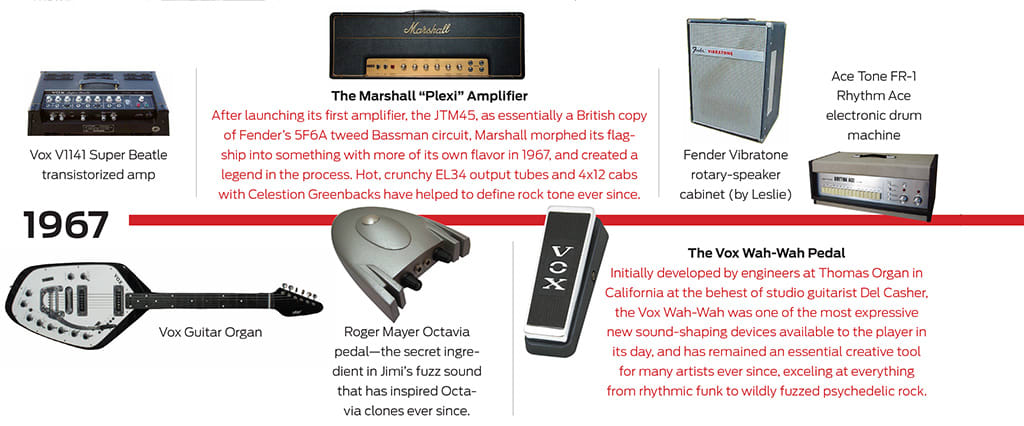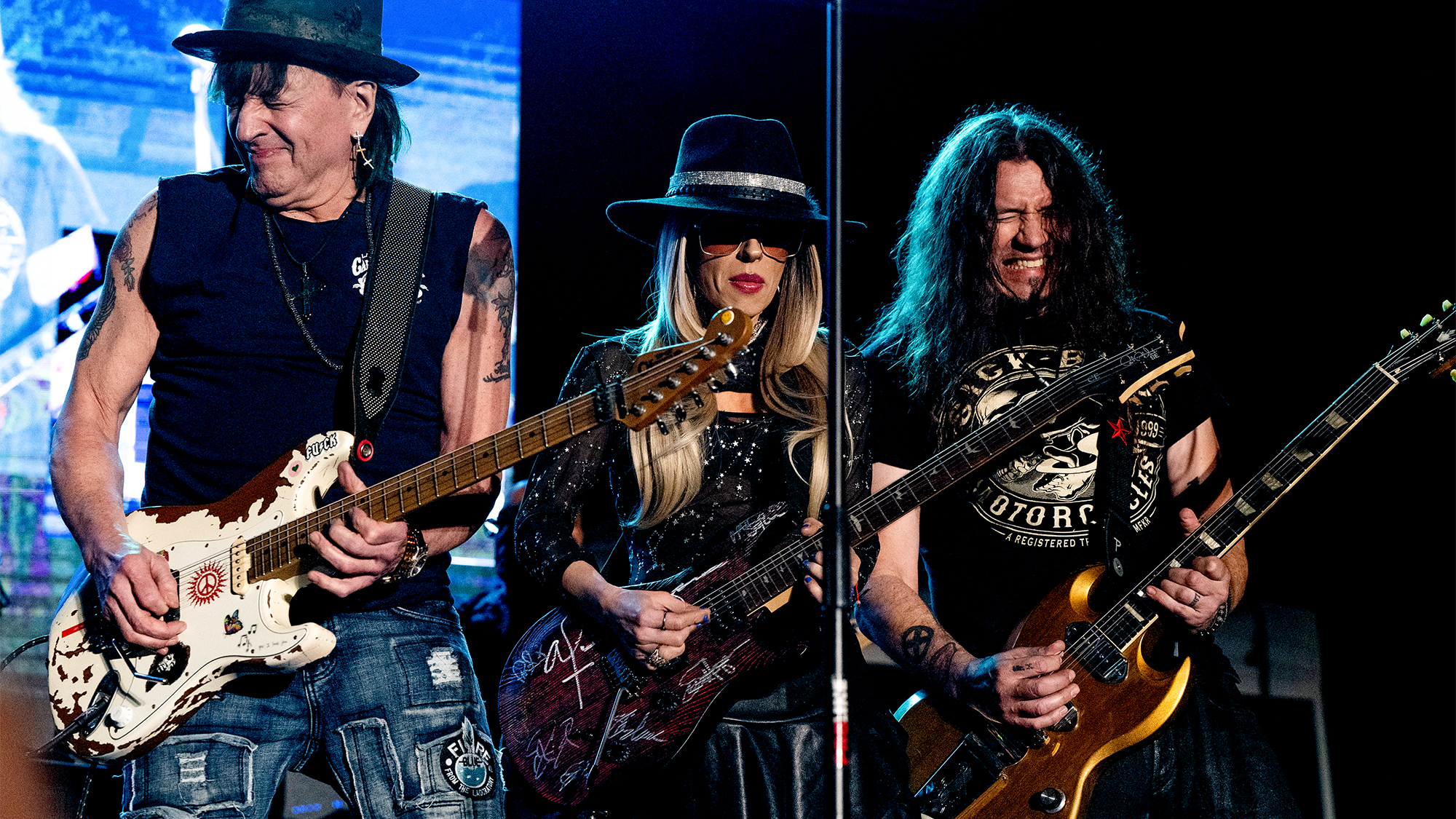50 Years of Extraordinary Players: Guitar Player Readers Name Their Favorite Guitarists
We asked readers to choose players who had kicked off their commercial careers during the magazine’s first 50 years 1967-2017
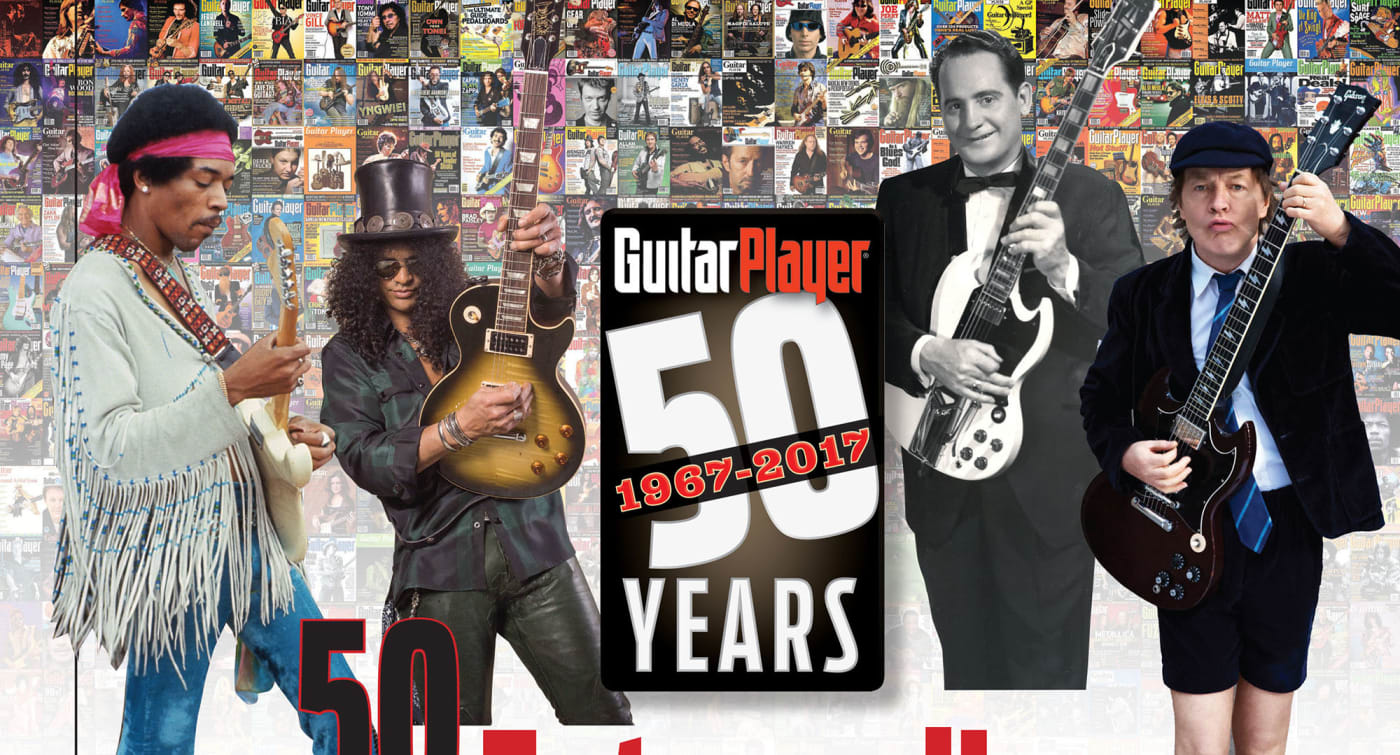
We’re guitarists, so we know how we are. We have elevated praising and blasting other guitar players to an Olympic-level sport. So the staff thought it would be fun to step out of the way for a 50th Anniversary issue feature lauding supreme guitarists between 1967-2017, and let you pick the honorees. Now you have no one to blame but yourselves for any omissions, controversies, or blasphemies. Hahaha.
Seriously, though, we felt it would be appropriate and immensely interesting to turn the selections over to you, as the readers have supported this magazine and all of the musicians it has written about in its pages for 50 years. You have been an essential part of GP’s longevity and success. We appreciate that fact more than you could ever know, and we trust your collective wisdom.
To collect your votes for this feature, we posted a “redacted” image of the October 2017 cover with all of the images blanked out on Facebook on July 14, and we asked that you name your most influential/inspirational guitarists. Getting to the list you see here required a bit of editing, of course, as there were thousands of names put up for consideration.
We determined that if a player was mentioned just once or twice, that wouldn’t be enough to get his or her name on the magazine’s list. Every player we left behind was an excellent guitarist, but we had to produce a manageable list—rather than a free-for-all of every player who ever touched an instrument—and we also wanted to see which guitarists a democratic, “majority rules” process would reveal. All of the players presented here were chosen multiple times by different readers.
We also asked readers to choose players who had kicked off their commercial careers during the magazine’s 1967-2017 anniversary timespan—which is why you don’t see Robert Johnson, B.B. King, Chet Atkins, and other seminal and legendary guitarists on the list. Placing the guitarists in certain decades was a bit of a conceptual challenge, as many artists have had long ramp-ups to public acclaim, and have also enjoyed extensive and fruitful careers. We opted to mark a player’s “decade of influence” either by the release of their debut album, the period of their most pivotal work (if an artist released one album, say, in 1979, but had the most impact in the 1980s, we put them in the ’80s), and/or their first major appearance in Guitar Player. We did this not to put artists into facile categories, but to show the evolution of players and styles—as well as our coverage of the community—throughout Guitar Player’s 50 years of publishing.
We thank everyone who participated in this fun and hopefully illuminating survey. There are obvious names on the list, for sure, but there are also some surprising mentions and strange omissions, and every selection celebrates the heart and soul and passion of GP’s reader community and the incredible players who have kept us thrilled and challenged the past 50 years. Bravo to all!
—MICHAEL MOLENDA
All the latest guitar news, interviews, lessons, reviews, deals and more, direct to your inbox!
Gear Innovations and Evolutions
By Art Thompson And Dave Hunter
In the 50 years that Guitar Player has been printing magazines there have been incredible highlights in the development of gear. Back in 1967 when GP began writing about all things guitar, the equipment landscape was evolving right along with music. Amplifiers were getting bigger and louder as Marshall and Vox vied for arena supremacy, effects took a big leap forward with the advent of the Vox Wah-Wah (followed closely by the famous Uni-Vibe), and in 1969 alone, Mesa/Boogie launched its revolutionary Mark I combo, Ampeg went power-mad with the SVT, and Electro- Harmonix etched its place in stompbox history with the Big Muff.
Whew! As if a fuse was lit on an innovations skyrocket, the number of guitar-product launches from that point to where we are today has been pretty mindblowing—and GP has been along for the ride all the way with in-depth reviews, large-scale shootouts, and all the advertisements that have graced the pages each month. It’s been an honor and a privilege to have helped spotlight some of the most important guitar innovations to come along, and we hope you enjoy looking back on some of those noteworthy releases via this 50-year timeline.
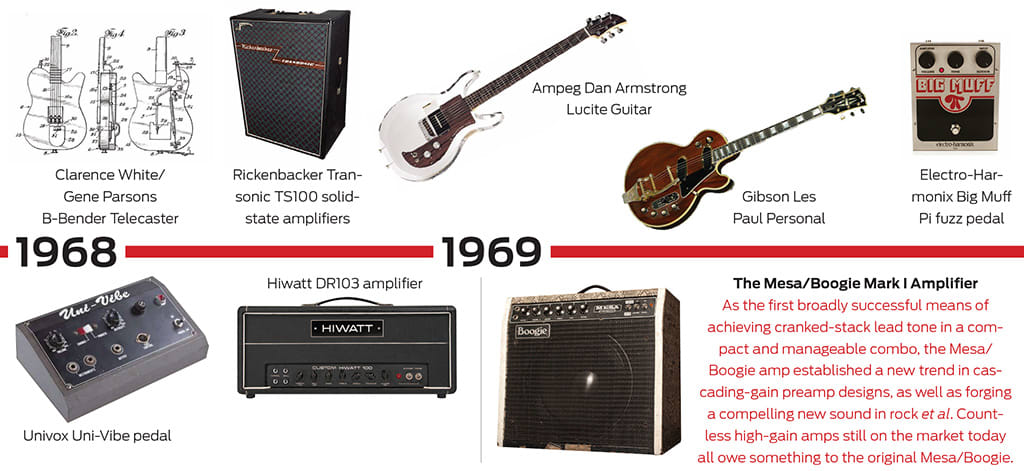
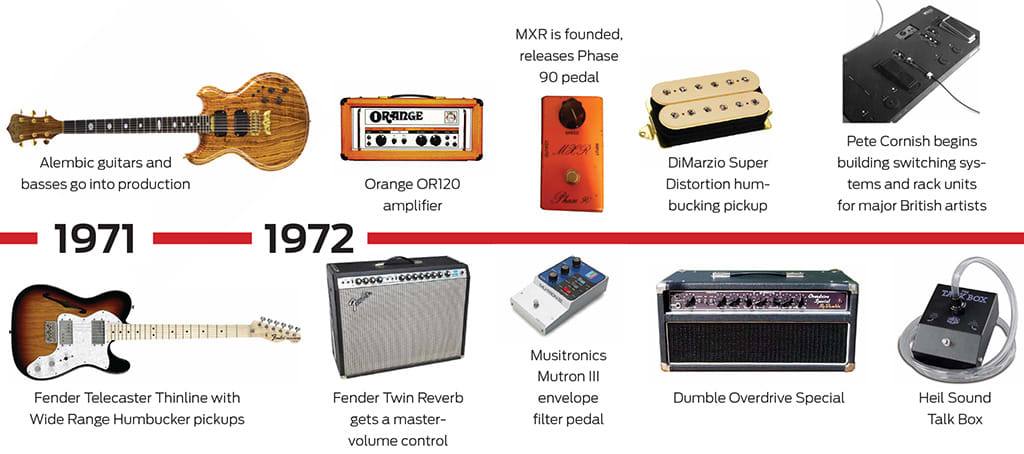
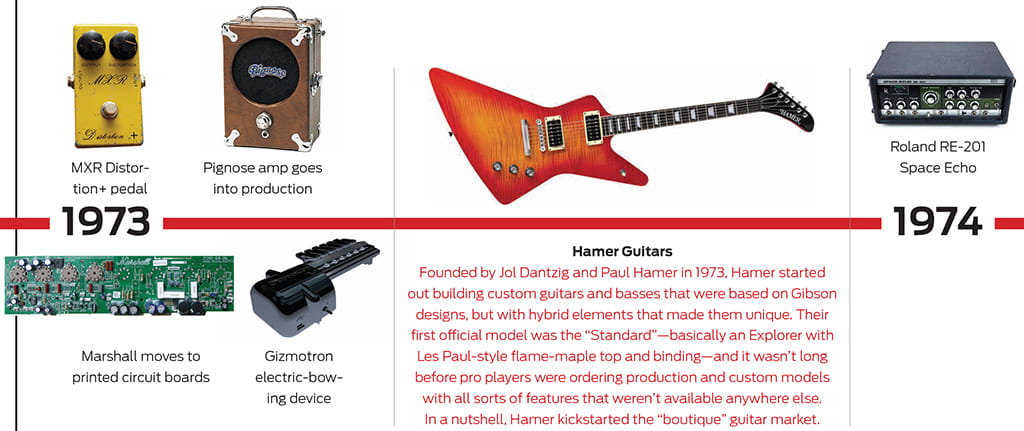
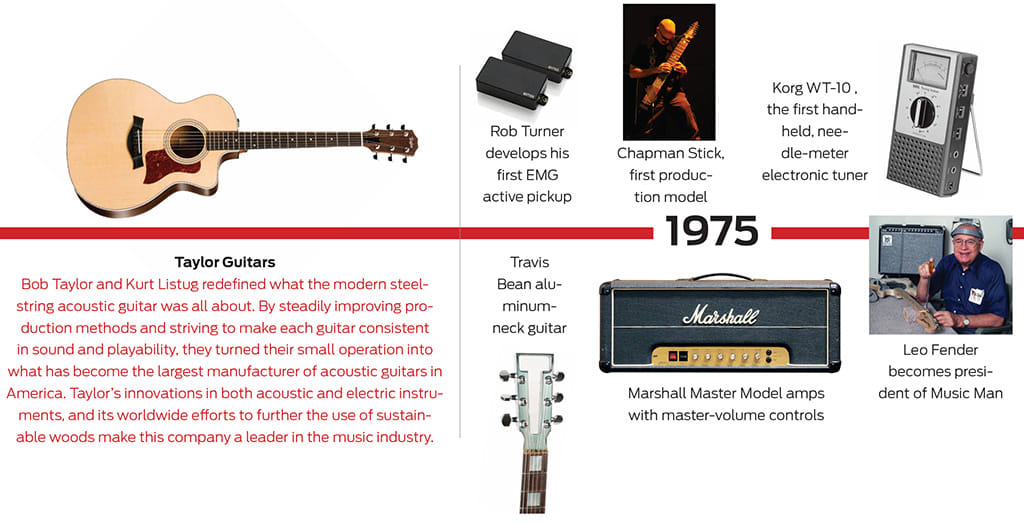
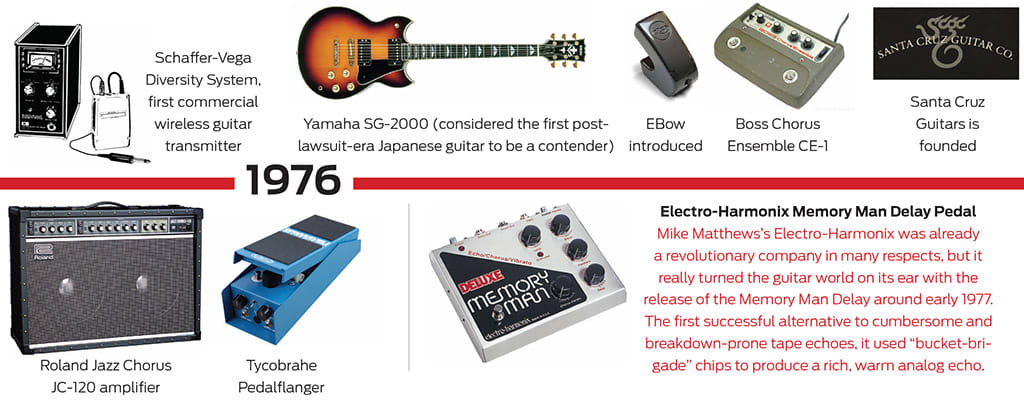
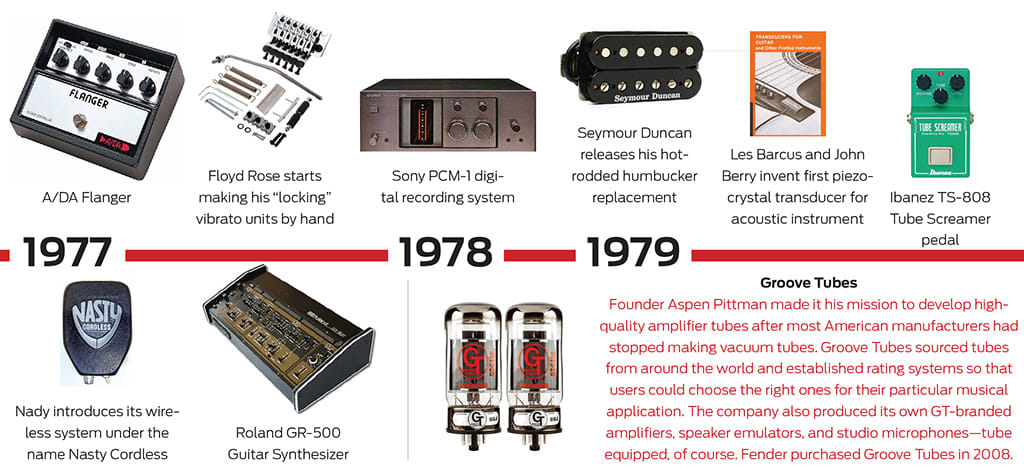
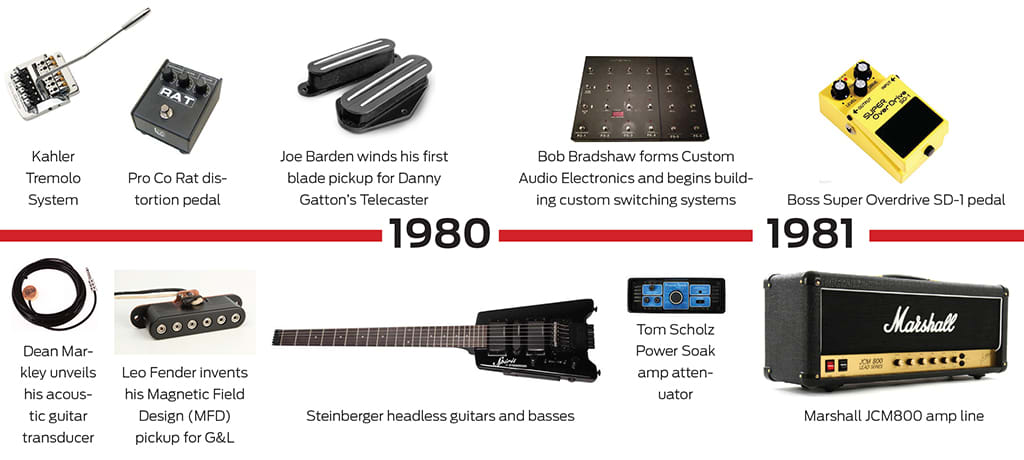

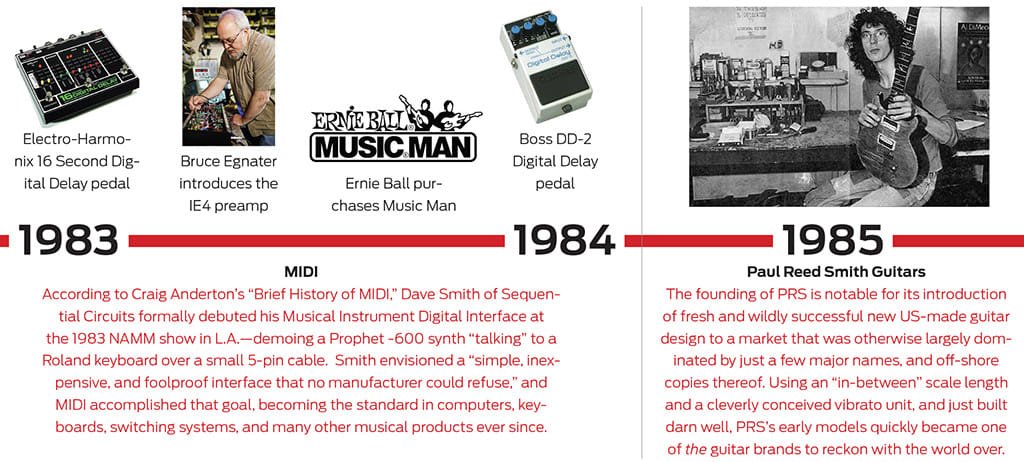
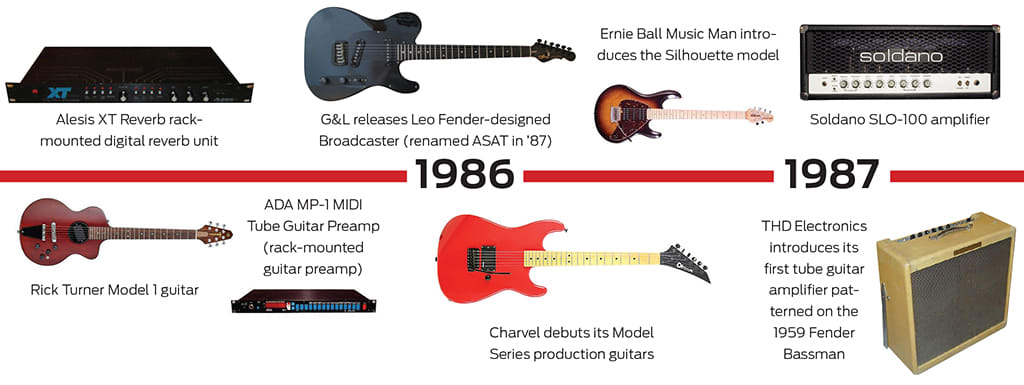
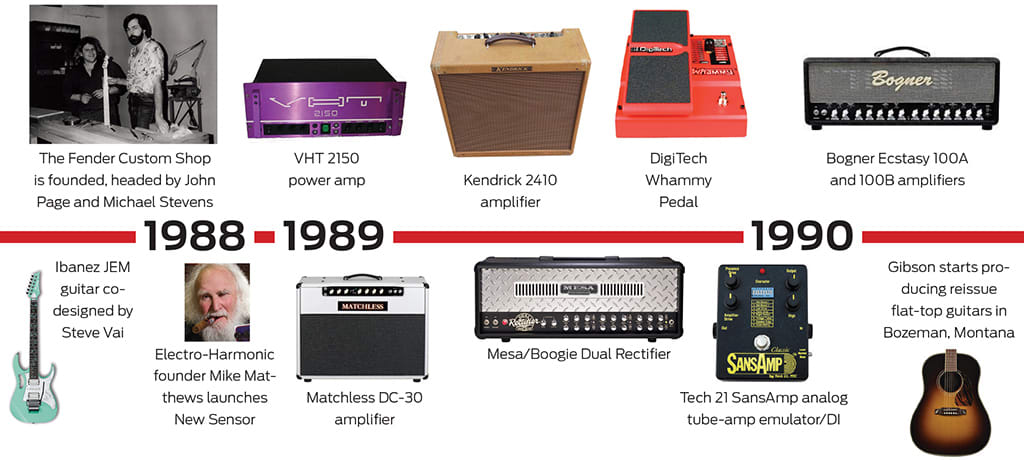
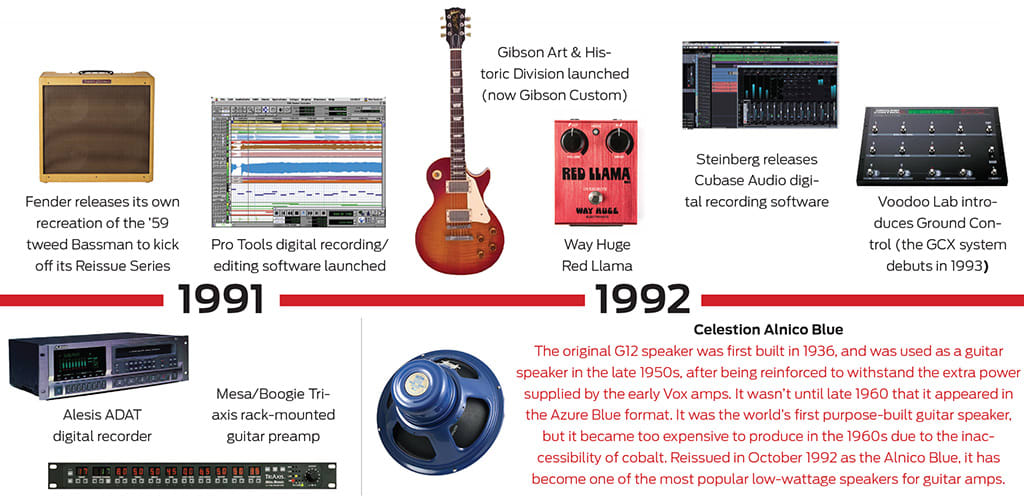
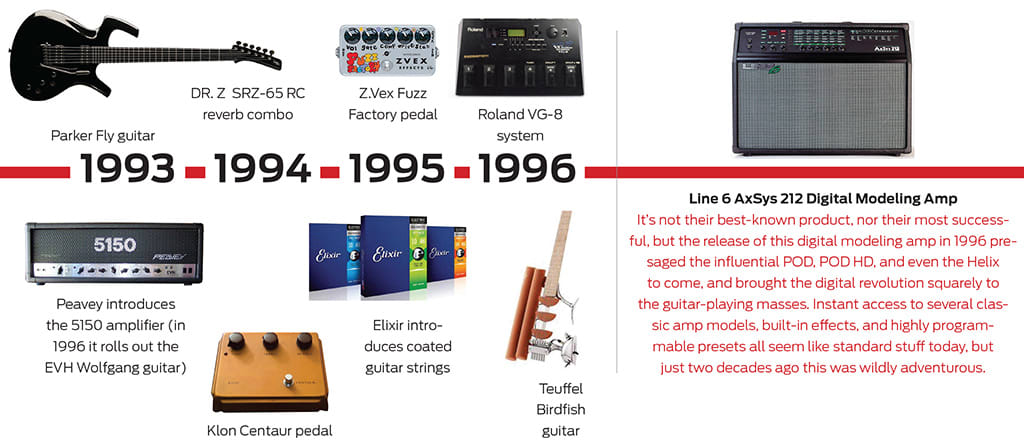
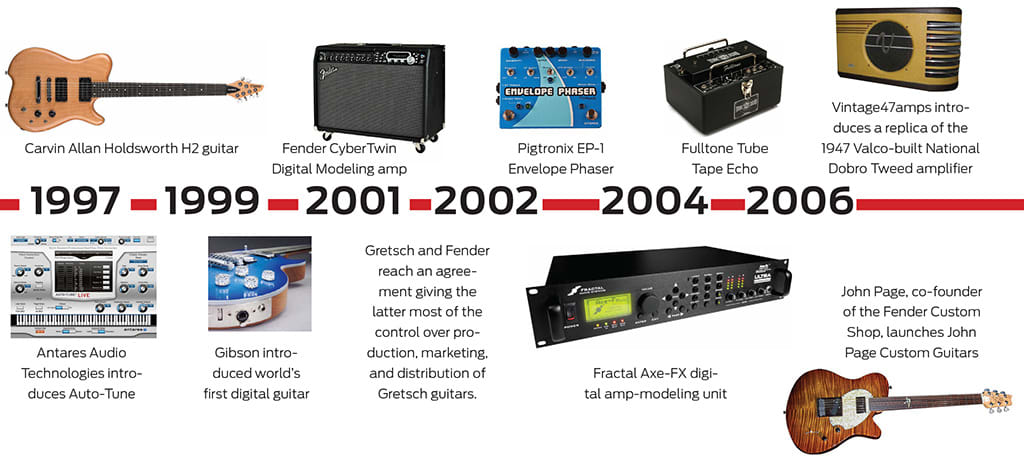
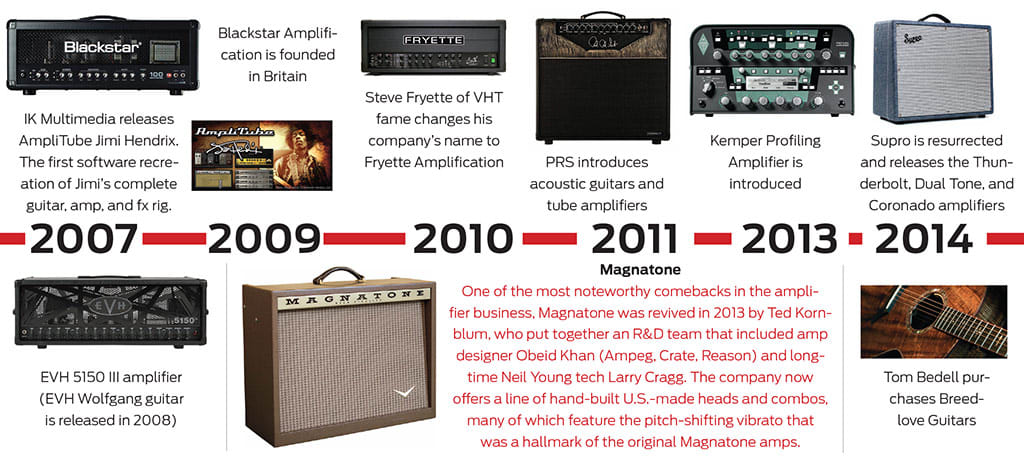
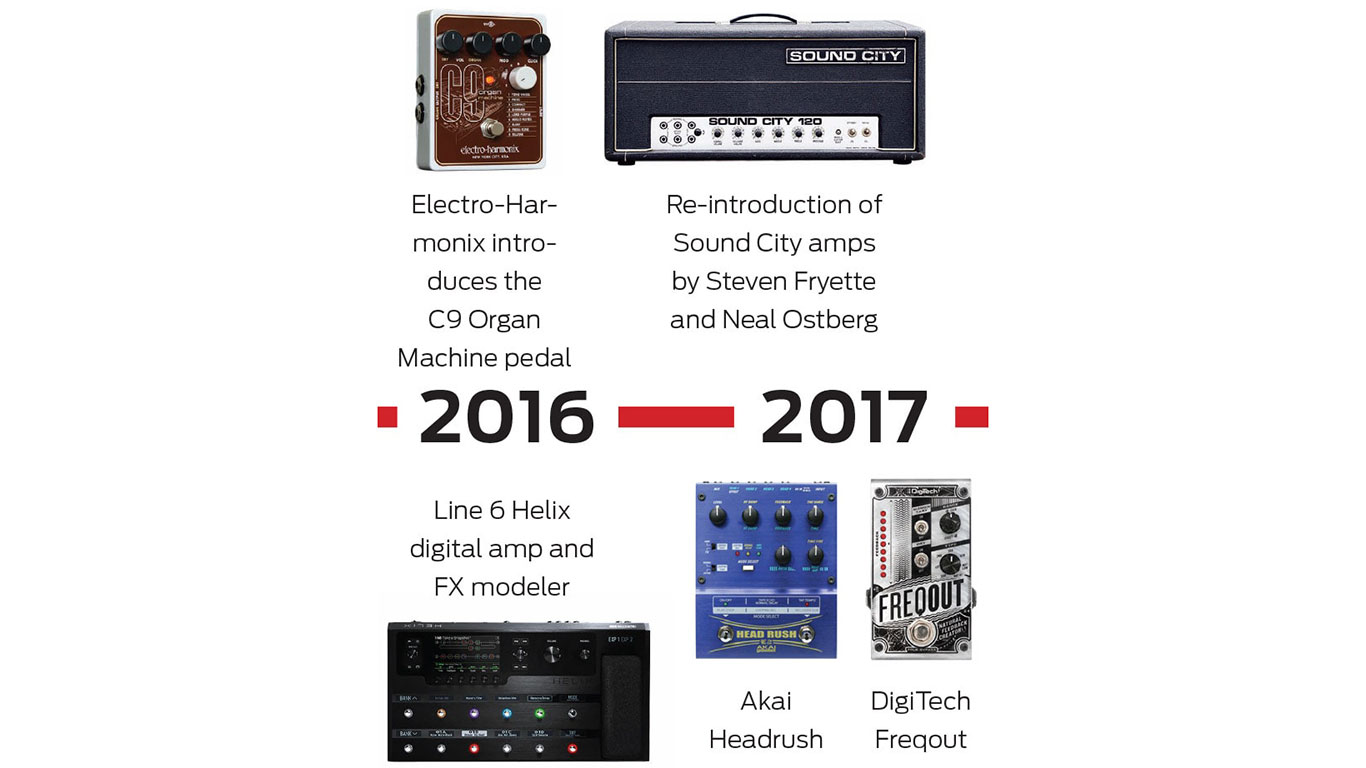
The one and forever king

ALLAN HOLDSWORTH IS IN READERS’ HEARTS AND MINDS BIG TIME
Perhaps it was the still-wrenching memory of losing him on April 15, 2017. Or maybe it was the continuing awe and respect guitarists hold for his supernatural technical and creative powers. It was most likely a heartfelt blend of both, because when we asked the GP community to select its most indispensable guitar heroes, it responded with a colossal barrage of votes for Allan Holdsworth.
When we tallied your selections, Holdsworth was named almost ten times more than any other player. Furthermore, your impassioned and well-considered praise for this transcendent artist through Facebook and Twitter posts forged a communal tribute that was informative, celebratory, and powerful. Here’s a sampling of reader comments…
“Holdsworth represents how the past (overdriven blues-based pentatonic playing) paved the way for the future,” says Todd Mason. “He was melodic in a way few are, and with a compositional sense like Debussy. He was technical in a way few others were. If there was no Holdsworth, there would be no Van Halen in the way we know him today. When I think of how many people picked up a guitar because of what Allan did, it boggles the mind. He was a genius, and one who would do kind things, such as donate guitars to children who had no money of their own to get them playing.”
“Allan Holdsworth was the most important guitarist since Hendrix,” says Gary Bryans. “He developed a totally unique approach to guitar, both musically and technically, and he influenced a whole generation of players from EVH onwards. RIP, Maestro.”
“Out of all of the influential guitar players worldwide, Allan will be one of the most remembered in the history books when all is said and done,” says Rob Norris. “His immense contributions to guitar, composition, and sound are too numerous to catalog here. This is Allan Holdsworth’s time to be heralded and recognized, as he should have been in his lifetime.”
“The man every other world-class guitarist on the planet aspires to be like, but have to settle for lowering their expectations by 1,000 percent,” says Ian Hartley.
And we also received a short, poignant note from Holdsworth’s daughter, Louise: “I vote for Allan Holdsworth—although I may be biased. RIP, Dad.”
—MICHAEL MOLENDA
Faces in the Crowd
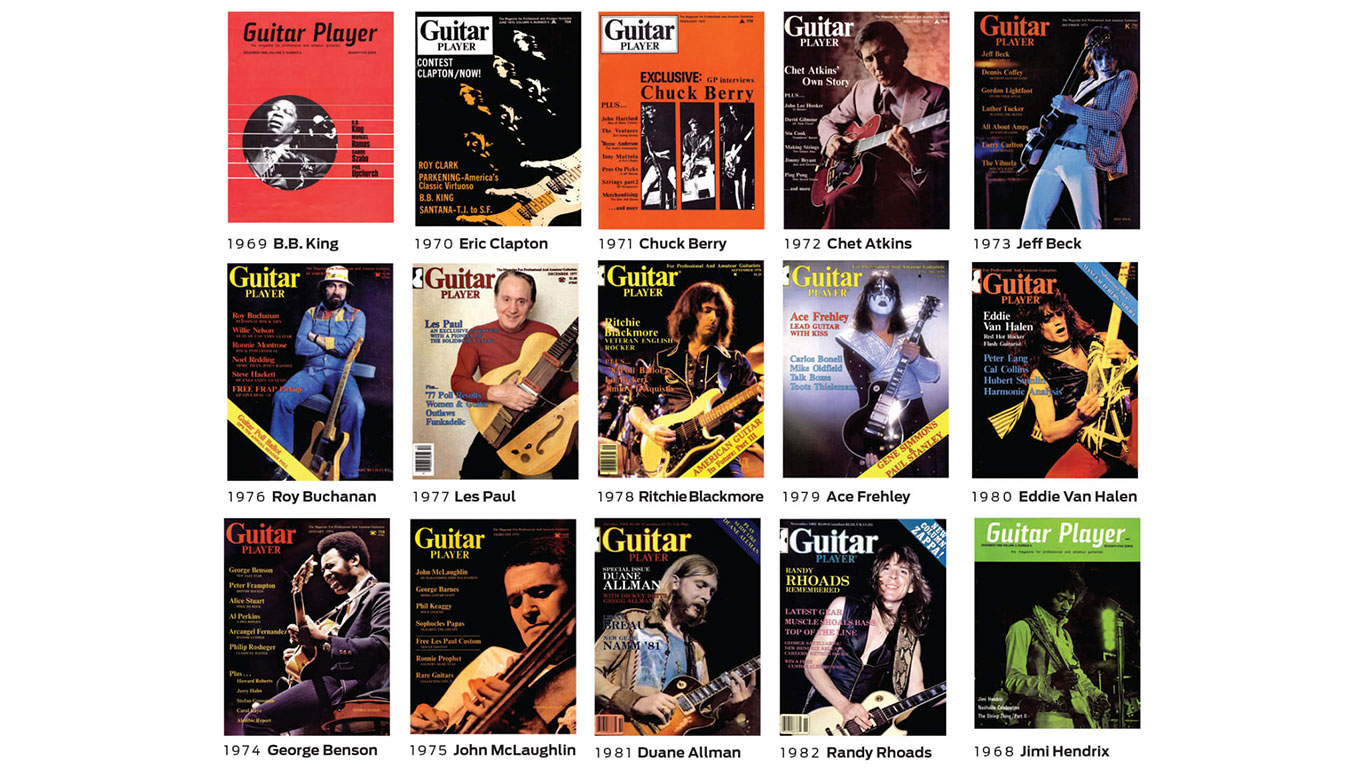
TOP COVER ARTISTS OF THE YEAR, 1967-2017
BY MICHAEL MOLENDA
In its 50 years of existence, Guitar Player has produced more than 600 covers. That’s a mammoth assemblage of awesome guitar players peering at you from newsstands or from the bottom of your mailboxes over five decades. Of course, not every cover in the magazine’s history showcased a specific artist—far from it. GP covers have also promoted conceptual themes, gear shootouts and guides, technique and style lessons, how-tos, career advice, and more.
Subject Matter
Throughout the past 50 years, showcasing major and up-and-coming artists has been our go-to cover-design tactic. But putting the faces of famous guitar players on the cover isn’t the only way to excite readers about the magazine, and, quite frankly, that approach would get boring if we never varied the cover content. Here’s a survey of Guitar Player cover themes from our debut in 1967, right up to the issue you’re holding in your hands.
However, when we posted a note on Facebook asking the community what type of content readers would like to see in our official 50th anniversary issue, Lyle Ketchum suggested that we pore over 50 years of artist covers and select the top players from each year. He basically set us up to be pummeled by hordes of readers angered that their personal hero didn’t get selected. (Thanks, Lyle!) But we thought about his idea, and we determined it was a fun way to showcase some “vintage” GP covers, as well as celebrate a timeline of wonderful guitarists throughout the years.
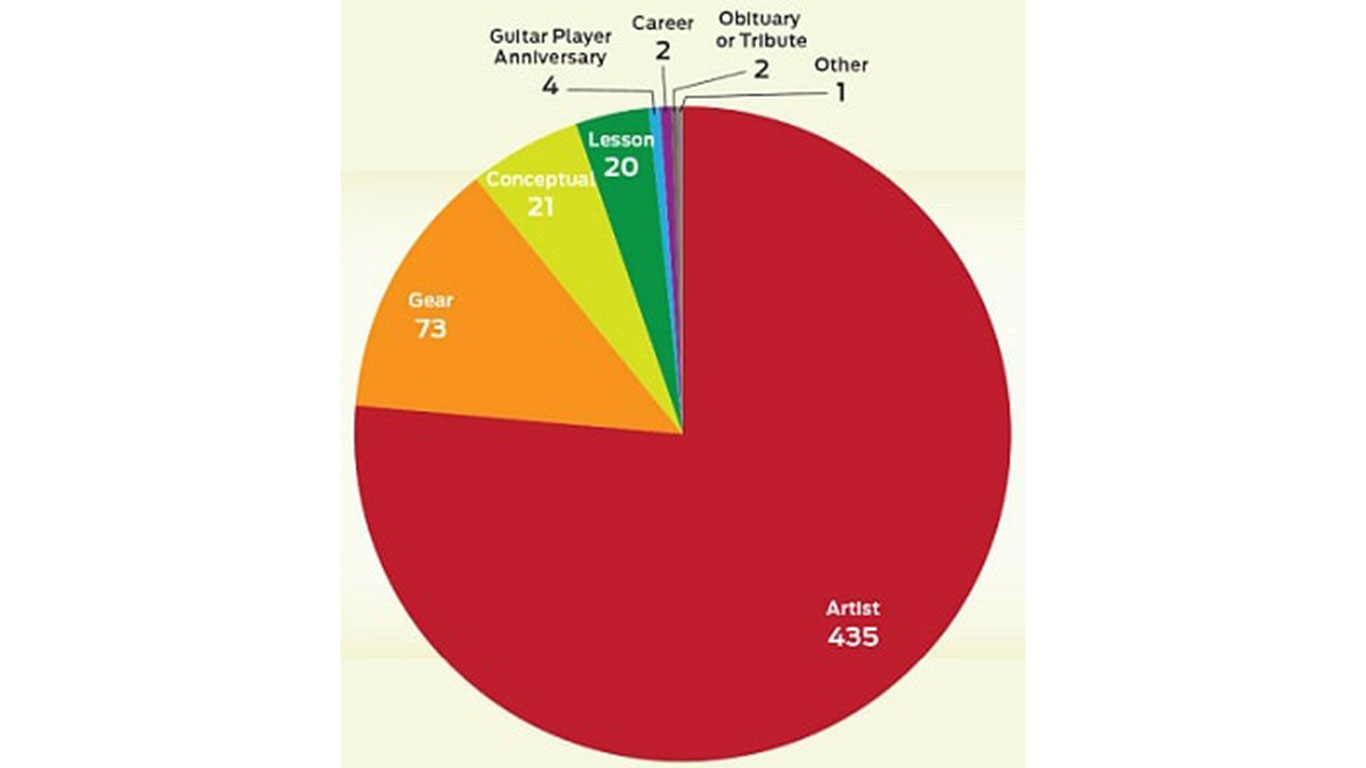
Here’s how we made the year-by-year selections: [1] The artist had to personify that year’s guitar culture (by popularity, game-changing technique, and/or guitar-community stature) or harken back to an essential point of the guitar’s history (if a tribute or obituary article); [2] Once selected, an artist could not be chosen again (to give more players a chance for recognition); [3] Our first year, 1967, was not included, as, believe it or not, we didn’t put any artists on the four covers produced that year; [4] We did include 2017, as we already know the cover artists for the remaining months of this year.
We hope you enjoy this little jaunt down memory lane—even if you plan to sling nasties at us for forgetting a hero or two (or three). One thing is incontestable, however: GP has covered an epic multitude of incredible guitar players since 1967.

Style Mapping GP Covers
This might be an exercise in imprecision, as some players are known for straddling stylistic boundaries, but we though it would be fun to match 50 years of GP cover artists to the main styles they represent. Above is a causal tally of how many times a particular style “owned” a Guitar Player cover. (Please note: Only covers bearing a single cover artist were calculated. Conceptual covers and covers showcasing multiple players were left out of the mix.)
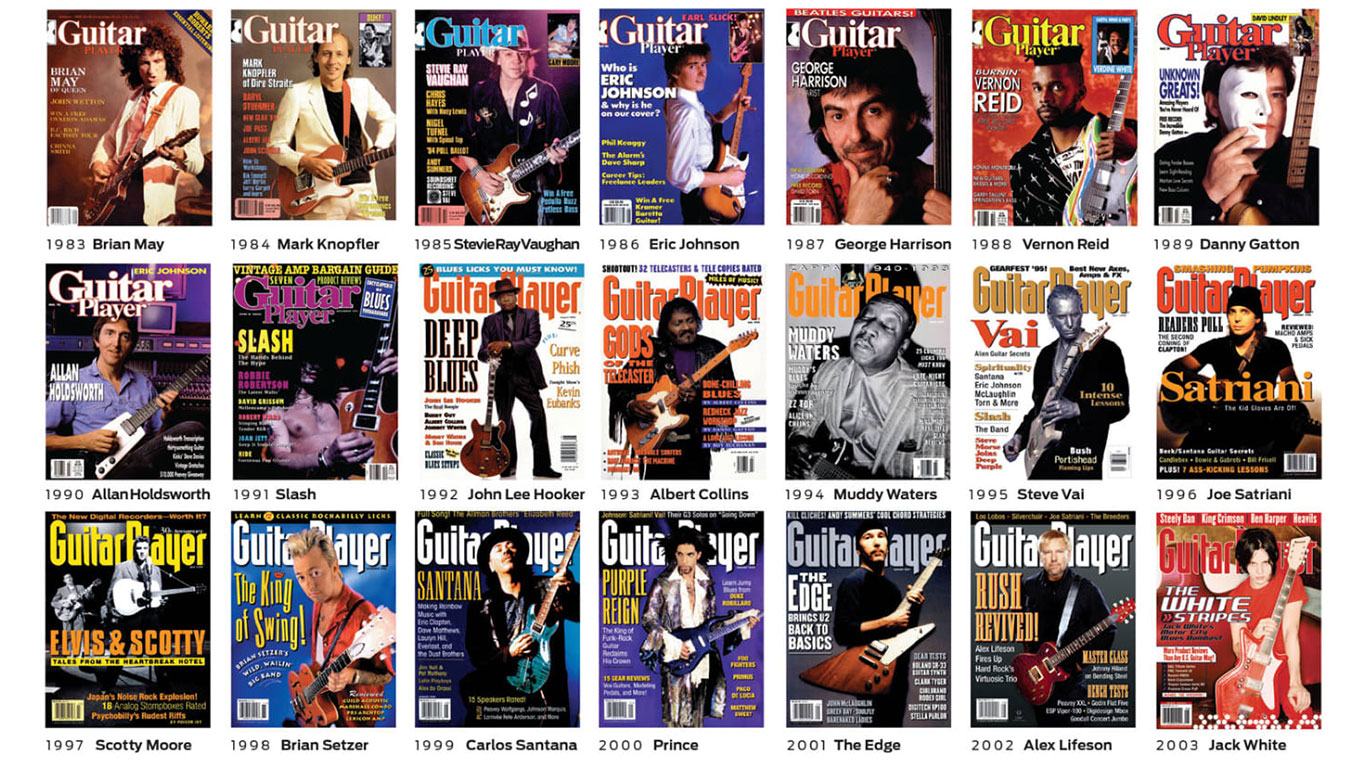
MIA?
Obviously, a ton of male and female guitarists did not make our list of “top cover artists by year.” While the selections skewed 100-percent male, we made our picks based solely on a specific year’s most influential, groundbreaking, or popular player, without regard to sex, style, or age. That said, non-male guitarists have graced GP covers in every decade. Here’s a look-see…
60+ noteworthy guitar albums of the past 50 years
BY THE GP STAFF
We may have missed the early Blues and jazz sides, Les Paul’s sound-on-sound masterworks, and the birth of rock and roll guitar, but Guitar Player’s launch in 1967 still made it possible for us to cover tons of incredible and historic moments in the evolution of recorded guitar playing. In 50 years of reporting on players, performances, tones, and techniques, we’ve documented literally tens of thousands of albums. It would be extremely difficult to look back at all of those releases and select a “top albums” list for our 50th Anniversary issue—especially one that explicitly represents guitar history and our reader community.
So we didn’t.
Instead, we opted for a collection of notable albums that exemplifies GP’s diversity of styles, genres, and players. There are some obvious choices on our list, to be sure, but there are also some perhaps unexpected surprises—due to the fact we tried to pick albums that would stand for jazz, country, acoustic, punk, and, hopefully, most of the music-culture revolutions, disruptions, and popular movements of each decade. We didn’t want to always be obvious or predictable, and we didn’t attempt to be comprehensive or all-inclusive. We’d need the page count of a hefty reference book to go that route. Our goal was to create an “overview” of what was happening across the many threads of guitar love during GP’s 50 years of serving all guitar players and fans of guitar music.
We’re aware a few choices may be controversial, that some massively huge albums are AWOL, and that we’ll get a bazillion angry and/or happy emails over the whole thing. To that end, we want to invite you to help us post a web story on the GP community’s picks of their favorite albums between 1967 and right now. Please send your votes to mmolenda@nbmedia.com, and we’ll get your voices heard.
The staffers and freelancers who contributed to this report—along with me—are Art Thompson, Jude Gold, Dave Hunter, Jimmy Leslie, and Michael Ross. A special “bravo” and shout out goes to Michael Ross, who really dug into the project, and provided the team with a very firm foundation of options. (Thanks, Michael!) We all hope you enjoy our little jaunt down GP’s “History of Noteworthy Guitar Albums, 1967-2017.” (All recordings are in the order of their release date, and all artist quotes appeared in GP interviews.) Don’t forget to check out some of the songs from these albums on YouTube, as there is a whole galaxy of cool guitar licks you can absorb from these bands and instrumentalists.
—MICHAEL MOLENDA
1967-1969
The Fastest Guitar in the Country
Jimmy Bryant
The radio deejays of the day thought this was studio trickery. It wasn’t. Bryant was that fast. Released 1967. Produced by Scott Turner.
“Frankly, I’d rather play fiddle than guitar, because you can get more phrasing out of a fiddle,”
—Jimmy Bryant
Are You Experienced
Jimi Hendrix
For many, our first real taste of the unbridled majesty of the electric guitar—and it was all over Top 40 AM radio, too! Released May 12, 1967. Produced by Chas Chandler.
“I like to play lead sometimes so I can express myself. But the way I play lead is a raw type of way— it comes to me naturally.”
—Jimi Hendrix
Born Under a Bad Sign
Albert King
No Albert King, no Stevie Ray Vaughan. Si m p le as t h at . Released August 1967. Produced by Jim Stewart.
“ I play a few chords, but not many. I concentrate on my singing guitar sound— more of a sustained note.”
—Albert King
Disraeli Gears
Cream
Eric Clapton goes psychedelic, but still celebrates the blues. Released November 2, 1967. Produced by Felix Pappalardi.
“Cream made me very bitter about being successful. When we first came here [America] to play, our egos really broke loose. We thought we were god’s gift. Then, the bubble burst, and we started to get put down by the press.”
—Eric Clapton
Super Session
Mike Bloomfield, Al Kooper, Stephen Stills
The dawn of the supergroup— ofsorts. Bloomfield’s unexpected (and unexplained) absence necessitated Kooper bringing in Stills to finish the album. As a result, one side belongs to Bloomfield, the other to Stills. Released July 22, 1968. Produced by Al Kooper.
“I thought Clapton had taken the blues just absolutely as far as it could go. And when Hendrix came along, I wanted to burn the guitar. I’m sure Eric felt the same way.”
—Michael Bloomfield
Truth
Jeff Beck
The 6-string sorcerer’s debut solo album—plus Ron Wood (on bass!) andRodStewart.
Released August 1968. Produced by Mickie Most.
“I’ve spent half my life trying to get out of ruts.”
—Jeff Beck
Led Zeppelin
Led Zeppelin
Jimmy Page conjures hard rock, textural guitar, and one of the coolest drum sounds ever, and ups the game of record producers everywhere.
Released January 12, 1969. Produced by Jimmy Page.
“I’ll always leave the mistakes in. I can’t help it. You’ve got to be reasonably honest about it.”
—Jimmy Page
Tommy
The Who
Peter Townshend’s rock opera proved heavy guitar could support and embellish grand concepts. Released May 23, 1969. Produced by Kit Lambert.
“I started smashing guitars when we were doing long feedback buildups. We wanted to go a bit farther each night, but we didn’t have any more volume, musical ideas, or musical dexterity. All we could do was freak out!”
—Pete Townshend
In a Silent Way
Miles Davis
Miles’ first foray into his “electric” fusion period, aided and abet ted by John McLaughlin. Released July 30, 1969. Produced by Teo Macero.
“When I heard Miles Davis, it completely blew away my previous concepts of how to improvise. That hard bop movement was where it was at for me.”
—JohnMcLaughlin
6-and 12-String Guitar
Leo Kottke
Back in the day, it seemed like every college dorm room had this hugely influential album spinning on a turntable. Released December 1969. No producer listed.
“Picking up the guitar to me is like chewing your nails— it’s a nervous habit. In the process, things pop up. The ones I have to analyze are the ones which work the least, and the ones that just barrel through work great.”
—Leo Kottke
Echo from the Past… It’s Bad For You But Buy It,
Ace of Cups
San Francisco’s first all-female psychedelic band released no albums during its 1967-1972 lifespan, but this compilation of live tracks, demos, and rehearsals shows that women instrumentalists were rocking the Summer of Love.
1970s
Fanny
Fanny
While all-female bands date back to almost the dawn of music entertainment, Fanny was the first female rock band signed to a major label, and they indeed rocked. Sorry, Runaways. Released 1970. Produced by Richard Perry.
“I think a solo should be melodic first, and, if you are an exceptional player, you can make it melodic and disjointed at the same time. But that’s a difficult trip to play.”
—June Millington (guitarist, Fanny)
At Fillmore East
Allman Brothers Band
The album that broke the Allmans as a commercial and artistic force, and so appropriate that it was recorded in the band’s element— on a live stage where everyone could burn bright. Released July 1971. Produced by Tom Dowd.
“I heard Ry Cooder playing slide and I said, ‘Man, that’s for me.’ At first, everybody just lowered their heads— start it off fast and get it over with! But then, I got a little better at it.”
—Duane Allman
The Inner Mounting Flame
MahavishnuOrchestra
Marshaled by John McLaughlin, t h i s immensely influential jazz-fusion album reached number 11 on the Billboard jazz charts, and, surprisingly, also crossed over into the pop charts. Released August 14, 1971. Produced by Mahavishnu Orchestra.
“If someone thinks I play fast, they should hear John Coltrane.”
—John McLaughlin
Machine Head
Deep Purple
This guitar opus for Ritchie Blackmore influenced the evolution of heavy metal, and also produced one of the most-played riffs heard in guitar stores (“Smoke on the Water”). Released March 25, 1972. Produced by Deep Purple.
“The only way you’re going to get good on guitar— unless you’re a genius— is to copy. That’s the best thing just steal.”
—Ritchie Blackmore
The Atkins-Travis Traveling Show
Chet Atkins/Merle Travis
Two guitar giants, a stark yet organic production, and a Grammy for Best Country Instrumental Performance. Released 1974. Produced by Jerry Reed.
“Trying to copy licks from piano players was how I started using my right-hand fingers. I play with a thumbpick, but I don’t recommend it for other guitarists, because it produces a one-dimensional sound. You can get a lot more tone colorings with just the thumb.”
—Chet Atkins
Benson Burner
George Benson
This compilation of mostly Benson’s earlier work was the right release at the right time, and, soon, every cool guitarist was talking about him. Super sweet and soulful stuff. Released 1976. Produced by John Hammond, Sr.
“I never try to get away from the basic concept of a song. Even when I’m improvising, the melody of the song is always in my head— though the single lines and chords I use are all George Benson.”
—George Benson
Bright Size Life
Pat Metheny
Only 21 when this debut album was released, it’s a monster— and that’s before you realize that Jaco Pastorius is playing bass. Released 1976. Produced by Manfred Eicher.
“One thing that’s cool about a guitar trio is it’s a blank slate. There aren’t a lot of archetypes to say, ‘Okay, this is how you do it.’ It was open territory.”
—Pat Metheny
Live: Jimmy Witherspoon & Robben Ford
Jimmy Witherspoon/Robben Ford
This smoking live set is the jazz-blues bible. Released 1976. Produced by Jerry Goldstein and Mike Vernon.
“The blues is vocal music, and good blues-guitar playing has to come from the same place as singing does. You’re using notes—not words—but you’re saying the same things.”
—Robben Ford
Van Halen
Van Halen
One of those truly earth-shaking guitar albums. Everyone remembers where they were when they first heard Mr. Edward Van Halen. Released February 10, 1978. Produced by Ted Templeman.
“I don’t care if a solo is melodic or spontaneous. If it has no feeling, it’s screwed.”
—Eddie Van Halen
Dire Straits
Dire Straits
Mark Knopfler gives a master class in how to wallop highgain sounds with the beautiful tone of a clean Stratocaster. Released October 7, 1978. Produced by Muff Winwood.
“Finding parts [for a song] is a musical musician’s specialty. Parts are what make great records—not producers.”
—Mark Knopfler
1980s
Blizzard of Ozz
Ozzy Osbourne
There’s a messy history to this album (check Wikipedia), but it gave us the late, great Randy Rhoads, as well as some kickass metal classics. Released September 12, 1980. Produced by Ozzy Osbourne, Randy Rhoads, Bob Daisley, and Lee Kerslake
“My strength is my determination. I just want to keep getting better. I don’t want to be satisfied with myself.”
—Randy Rhoads
Boy
U2
The Edge unleashed a “stand-up-and-takenotice” guitar sound that was fresh and powerful. Did many of us buy delay pedals after we heard Boy. Duh. You bet we did. Released October 20, 1980. Produced by Steve Lillywhite.
“If you want to do something new, there’s no reason why you shouldn’t be able to. For us, it was an important lesson, and we’ve never put up with anything that lacked vitality or originality. We’ve always dumped it if we felt it smacks of an era gone by, or that it isn’t musically relevant.”
—The Edge
Friday Night in San Francisco
Al Di Meola/John McLaughlin/Paco DeLucia
Three transcendent players cut one of the most influential live acoustic-guitar albums of all time. Released August 10, 1981. Produced by Al Di Meola, John McLaughlin, and Paco DeLucia.
“I like the way the notes pop out when you mute. They project more, and I have always liked to play very percussively— which goes back to when I played drums before the guitar.”
—Al Di Meola
Texas Flood
Stevie Ray Vaughan and Double Trouble
Two days of recording with no overdubs produced an album that revitalized the blues and gave us an enduring guitar hero. Released June 13, 1983. Produced by Double Trouble, Richard Mullen, John Hammond.
“I got a lot of the fast things I do from Lonnie Mack—the ideas and the phrasing— and I got a lot of turnarounds from Freddie King. I also wanted to see how many places Albert King’s stuff would fit.”
—Stevie Ray Vaughan
Aerial Boundries
Michael Hedges
Hedge’s remarkable technical and creative arsenals—as well as his extreme, yet musical dynamic sensibilities and genre jumping—helped make this album an indispensable altar of the acoustic canon. Released 1984. Produced by Will Ackerman, Michael Hedges, and Steven Miller.
“I’m trying to be more primitive. I call it ‘savage myth guitar.’ The savagery implies it’s tough, and the myth implies that it’s mystical.”
—Michael Hedges
Rising Force
Yngwie Malmsteen
Just over a year since he appeared in GP’s February 1983 Spotlight column by Mike Varney, Malmsteen dropped this blazing beast, and defined— and perhaps even invented—shred guitar. Released March 5, 1984. Produced by Yngwie Malmsteen.
“Stop listening to other guitar players. Stop listening to me. Don’t do what I’m doing. Do something else.”
—Yngwie Malmsteen
Master of Puppets
Metallica
Metallica’s major-label debut was the first so-called thrash-metal album to go platinum. In 2016, it was preserved in the Library of Congress’ National Recording Registry. Released March 3, 1986. Produced by Flemming Rasmussen and Metallica.
“Metallica is an ensemble. There isn’t a lot of room for outrageous spotlighting. Someone might come in with a part they think is brilliant, and someone else will say, ‘That won’t cut it—you’re overplaying.’”
—Kirk Hammett
Unfinished Business
Danny Gatton
GP’s March 1989 cover proclaimed Gatton as an “unknown great,” and he was one of those supremely talented shooting stars who never enjoyed the success they deserved during their lifetimes. But, to those in the know, Gatton was a thrilling mix of technique and stylistic diversity. Released 1987. Produced by Danny Gatton.
“Part of the ability to play various styles correctly is attitude. There should be nothing condescending when you play something simple. I appreciate Link Wray’s ‘Rumble’ as much as I do Les Paul’s ‘How High the Moon’”
—Danny Gatton
Surfing with the Alien
Joe Satriani
Surfing’s impact on guitar culture was meteoric. The album was virtually all over 1987’s music scene— going platinum and getting nominated for Grammys—and it was an instrumental guitar album. Wow. Released October 15, 1987. Produced by Joe Satriani and John Cuniberti.
“I don’t discourage myself from going in one direction or the other. I’m more afraid of what would happen if I wasn’t excited about what I was playing.”
—Joe Satriani
Lita
Lita Ford
Ford’s duet with Ozzy Osbourne (“Close My Eyes Forever”), the rousing “Kiss Me Deadly,” and her frequent MTV appearances cemented her ’80s icon status. Released February 2, 1988. Produced by Mike Chapman.
“I’m not one for flashy performances. I go for the feel—not for speed or effects. A solo should come from the heart—a mini journey, a story, a piece of your life.”
—Lita Ford
1990s
Ah Via Musicom
Eric Johnson
Ah Via Musicom gave us the superlative “Cliffs of Dover,” which won a 1992 Grammy for Best Instrumental Rock Performance. Released February 28, 1990. Produced by Eric Johnson.
“I want my solos to have a kind of skimming-acrossthe- water sound. They should also have some lyricism and say something that moves me when I hear them back.”
—Eric Johnson
Cowboys From Hell
Pantera
Dimebag Darrell’s tremendous chops and aggro groove—as well as an equally ferocious band—made this one of the most inspirational and defining albums of the ’90s metal scene. Released July 24, 1990. Produced by Terry Date.
“I’m not going for soft sounds, and I ain’t looking for no warm sound. For what I do, I can’t get enough f**kin’ chunk. No one had grabbed ahold of that tone, so I built my sound around it.”
—Dimebag Darrell
Steve Vai
Vai has focused more on his compositional chops the past few albums, and this is the one that may have paved the way. His virtuosity is still burning, of course, but it shines within works that are cinematic, sensitive, powerful, and, at times, whimsical and humorous. Released September 1990. Produced by Steve Vai.
“Where do melodies come from? They can’t just come from grids and scales. They have to come from your mind’s ear.”
—Steve Vai
Ask the Ages
Sonny Sharrock
At times manic and blistering, other times spellbinding and melodic, Coltrane fan Sharrock turns jazz upside down and sideways, playing like (in his own words) “a horn player with a really f**ked-up axe.” Released August 6, 1991. Produced by Bill Laswell and Sonny Sharrock.
“When I improvise, I play the melody, and, by the time I reach its end, I want it to have led me to someplace else. There’s a point where you’re walking along the road, and then the road disappears from under your feet. But that doesn’t matter, because as you step, the road builds itself.”
—Sonny Sharrock
Nevermind
Nirvana
Everyone likes to say that this was the album that killed hair metal. It definitely rippled across pop culture, brought grunge into the mainstream, and inspired scores of kids to pick up guitars. Released September 24, 1991. Produced by Butch Vig.
“I’ve never considered musical equipment very sacred. I don’t like to be that familiar with my guitar.”
—Kurt Cobain
Unplugged
Eric Clapton
A massive hit for the “relaxed” Clapton, this set was the best-selling album in the MTV Unplugged series, and helped ignite another era of high interest in acoustic guitars and acoustic players. Released August 25, 1992. Produced by Russ Titelman.
“I think that jamming—unless it has a goal at the end of it— is pretty much a waste of time.”
—Eric Clapton
Rage Against the Machine
Rage Against the Machine
Tom Morello’s unique and electrifying blend of metal, punk, and hip-hop made him one of the most original guitarists of all time. Released November 3, 1992. Produced by GGGarth Richardson and Rage Against the Machine.
“Once you get off the beaten path of chords and notes, any noise can be its own microcosm of songwriting .”
—Tom Morello
Cover to Cover
Jeff Healey
Perhaps inspired by his bar-band role in 1989’s Road House, Healey puts his blues mojo in the service of (mostly) rock cover songs, and hits number one on the Billboard Blues Albums chart. Released June 13, 1995. Produced by Thom Panunzio and the Jeff Healey Band.
“There are an awful lot of people with a hell of a lot of technique and no soul. I have been fortunate to at least have the soul behind what I’m doing.”
—Jeff Healey
Nashville
Bill Frisell
The avant-jazz guitarist goes to Nashville, interprets country guitar, and recasts the style with respect, admiration, and a radiantly evocative vibe. Released April 29, 1997. Produced by Wayne Horvitz.
“Music has always been this world I could be in where anything was possible. I feel like I can go however far my imagination can go, and it will all be okay somehow.”
—Bill Frisell
Follow the Leader
Korn
The album that kicked nu-metal into the musical mainstream, and helped popularize 7-string guitars, low tunings, and sludgy heaviness. Released August 18, 1998. Produced by Steve Thompson and Toby Wright.
“I play strictly rhythm. I practiced lead so much when I was younger that I’m sick of it now.”
—Brian “Head” Welch
2000s
Only
Tommy Emmanuel
The acoustic shaman’s first solo-acoustic release was a master class of virtuosic performance. For the rest of us, blown minds, artistic envy, and renewed commitment to practice followed. Released 2000. Produced by Rod Tamlyn and Tommy Emmanuel.
“You’ve got to learn a new piece bit by bit, and with the understanding that it’s not music yet— it’s new skills. Eventually, you’ll start to focus on the melody, and then, all of a sudden, you realize, ‘I’m making music.’”
—Tommy Emmanuel
Sweet Tea
Buddy Guy
Buddy Guy blows minds with one of the most sonically adventurous blues albums of the decade. It was also the first time he interpreted Northern Mississippi-style blues, and he responded with absolutely feral performances. Released May 15, 2001. Produced by Dennis Herring.
“I told Dennis [Herring] I didn’t know enough about traditional Mississippi blues to play it [for Sweet Tea]. He said, ‘I don’t want you to know it. I want you to play Buddy Guy with what we’re going to give you.’”
—Buddy Guy
Origin of Symmetry
Muse
Guitarist Matt Bellamy’s re-tooled guitar tones, grand compositions, and film-noirlike production redefine the power trio for a new age and score massive world-wide pop hits, as well. Released July 17, 2001. Produced by Muse, David Bottril, and John Leckie.
“The guitar is a huge part of rock history, but, at the same time, I feel music is evolving away from the traditional rock format. I make modifications to my guitar—Kaoss Pads and onboard effects—that allow me to incorporate new and different sounds.”
—Matt Bellamy
Elephant
The White Stripes
Basic, glorious garage-rock guitar comes roaring back with a mammoth pop hit, and “Seven Nation Army” delivers one of the decade’s must-played riffs. Released April 1, 2003. Produced by Jack White.
“I usually limit myself to two guitars on a particular track. Once you get into three guitars, you might as well put 60 on there.”
—Jack White
Everybody Loves You
Kaki King
King’s technical power, unique creative voice, and dynamic performances produced one of the most singular and original instrumental albums in years—definitely a standard bearer for modern acoustic guitar. Released April 22, 2003. Produced by Kaki King.
“As a solo-acoustic performer, if you’re standing onstage for 45 minutes trying to keep people’s attention, you’re going to have to start screwing around with some interesting ideas.”
—Kaki King
De-Loused in the Comatorium
The Mars Volta
Prog-rock reimagined with epic melodies, riffs, and noises by guitarist Omar Rodriguez- López. Released June 24, 2003. Produced by Rick Rubin and Omar Rodriguez-López.
“The real way of winning over a crowd is by being yourself. For me, that means putting across where I’m at right now. I don’t understand the mentality of a band that builds its live show around the fact they had a hit once. Who cares! I prefer to adopt the same mentality as an unknown band that’s just starting out. We’re going to do our thing, and afterwards you can make your decision about whether we stuck in your head or not.”
—Omar Rodriguez-López
Live at the Georgia Theater
The Derek Trucks Band
We knew that Trucks had formidable chops and southern-rock roots, but this live set also established him as one of the premier jam-band guitarists of the decade. Released 2004. Produced by Derek Trucks Band.
“It’s easy to lose track of why you’re getting a sound if you analyze it too much.”
—Derek Trucks
Mafia
Black Label Society
When we put Wylde on our 2004 “redesign” cover, we had no idea he was planning such a masterstroke of shred, pop metal, societal reflection, balladry (“In This River”), and stunning guitar-craft. Wow. Released March 8, 2005. Produced by Zakk Wylde.
“To get fast on guitar, you just have to play everything a million times. It’s a matter of repetition and practice. If you don’t use it, you’ll lose it.”
—Zakk Wylde
Play
Brad Paisley
A celebration of modern-and vintage-country guitar that also included guests James Burton, Albert Lee, Vince Gill, and Brent Mason. B.B. King joins the party, as well. Released November 4, 2008. Produced by Frank Rogers.
“Play was a chance to do things I would never get away with on a country record. Of course, the country guitar playing comes through—I can’t help sounding like me—but it was a great feeling to be completely unrestricted.”
—Brad Paisley
Live From The Royal Albert Hall
Joe Bonamassa
The hardest-working bluesman in show biz delivers a roaring, stomping set that shows how he revitalized the blues for new audiences. Released September 22, 2009. Produced by Kevin Shirley.
“My goals have always been pretty simple. I just want to play my guitar—no more, no less.”
—Joe Bonamassa
2010-2017
Nightlight/Daylight
Muriel Anderson
A beautifully produced song cycle of slumber and awakening to a new day—all informed by Anderson’s wondrous acoustic chops and sensitive compositional approach. Released March 2014. Produced by Muriel Anderson and Mark Kibble.
“Find the thing you do that is unique, and that will enhance the quality of someone’s life so much that they would actually be happy to pay for it.”
—Muriel Anderson
Live
Gary Clark, Jr.
The current hero of the blues lays it down in an onstage environment— great solos, cool swagger, and blissfully raw. Released September 14, 2014. Produced by Rob Cavallo.
“In this day and age of music, anything could be made in the studio, so it’s a testament of your honest skill and talent to show what you can do in a live setting with no tricks.”
—Gary Clark, Jr.
Let Love Show the Way
Simo
A brilliant hybrid of soul, country, southern rock, and psychedelic craziness that completely kicks ass. Released September 23, 2014. Produced by J.D. Simo.
“One might argue some of the best improvisers in history were extremely inconsistent, but the great performances happened because they were always reaching.”
—J.D. Simo
Still
Richard Thompson
The master British folk-rock songwriter and guitarist teams up with Wilco’s Jeff Tweedy and adds tons of guitar colors to his compositions. Gorgeously spooky and vibey. Released June 23, 2015. Produced by Jeff Tweedy.
“The performances I like most are the ones in which the guitar is playing around the structure of a song—providing some interesting musical development from verse to verse. I like to harmonically tease things along so I’m almost evolving the narrative along with the singer. I’m telling an instrumental story against the vocal story.”
—Richard Thompson
Arclight
Julian Lage
Jazz on a Fender Telecaster and it works marvelously—vivid, articulate tones and supremely dynamic phrasing with a punch. Released March 11, 2016. Produced by Jesse Harris.
“What I love about the Telecaster is the feedback you get from it. It really sounds like the person playing it, and it was comforting to see that just because you play a Tele, it doesn’t mean you have to play Tele music.”
—Julian Lage
Silk Around the Marrow
Dagger Moth
Italian experimental guitarist Sara Ardizzoni creates live loops with guitar tones that animate her songs by being angular, brash, off-kilter, ambient, lovely, or fuzzy and biting—sometimes in the same tune. Released Apri l 21, 2016. Produced by Sara Ardizzoni.
“I often go down unforeseen pathways in order to keep myself from getting bored.”
—Sara Ardizzoni
The Marcus King Band
The Marcus King Band
We featured King in our September 2017 “Youthquake” cover story, and this Warren Haynes-produced release documents an “old soul” with a glorious tone, dazzling chops, and a reverence for the past. Released October 7, 2016. Produced by Warren Haynes.
“When someone plays directly from the heart, rather than thinking too much, that’s when you find the likes of a Duane Allman or a Bukka White.”
—Marcus King
The Madness of Many
Animals as Leaders
Guitarist Tosin Abasi is the guitar hero of the new prog-metal and djent movements— and he owns it with smarts, compositional originality, great tone, and awe-inspiring chops. Released November 11, 2016. Produced by Animals as Leaders.
“The culture around guitar playing has been reignited. People want to study advanced concepts and techniques—things that were definitely not in vogue a while ago.”
—Tosin Abasi
Abandon All Hope
Gretchen Menn
The Defiant Machine
LoNero
Both of these young guitarists opted to make their instrumental- guitar offerings special by tackling thematic concepts—Dante’s Inferno for Menn, and the world of war for LoNero—that informed their compositional approaches with striking tones, dramatic melodies, and cinematic wonder. Abandon All Hope released December 12, 2016, and produced by Gretchen Menn and Daniele Gottardo. The Defiant Machine released May 26, 2017, and produced by Bill LoNero and Andy Watters.
“Instrumental music, for the most part, is a very safe thing to listen to, but it never puts you on edge. I’m a huge fan of Metallica, so I wanted to be aggressive. War and instrumental doesn’t go hand in hand, but war and metal does, so I tried to combine the two.”
—Bill Lonero
“I’m not somebody who likes a ton of effects. I like a guitar to sound like a guitar. But if it’s going to sound like something other than a guitar, I don’t want it to sound like a synthesizer. I’d rather it sound more like other stringed instruments.”
—Gretchen Menn
Way Out West
Marty Stuart and His Fabulous Superlatives
Who knew? Stuart abandons his usual trad-country style for a divine and ghostly atmospheric tale of the American West. Every guitar part, riff, and melody tells a story, and all of the guitar tones are either achingly beautiful or as mean as an angry steer. Released March 10, 2017. Produced by Mike Campbell.
“Whether I am writing songs, taking pictures, playing guitar or mandolin, hosting a TV show, or making up a set list, it is all the same world to me. It is all creative architecture, and I love every aspect of it.”
—Marty Stuart
Five Decades of Thrills & Disruptions
SOME KEY CULTURAL MOMENTS DURING THE GUITAR PLAYER ERA
BY MICHAEL MOLENDA
Most artists do not live in impenetrable bubbles where they conceive work solely from the firestorms raging in their right brains. They desperately need the world around them to inspire beauty, horror, anger, bliss, and all of the other elements that trigger creative action. So we thought it would be fun—and possibly instructive— to look into some of the cultural, technological, political, and musical events that swirled around guitarists between our first issue in 1967 and today. It’s far from a comprehensive timeline—and it’s more focused on entertainment than world or U.S. politics— but it provides some brief and amusing nuggets regarding the environments surrounding guitarists as they composed their riffs, songs, and solos throughout the past 50 years. Did any of these events forge or inform your own compositions or musical style back in the day? If you have any cool stories about your artistic journey, send them my way at mmolenda@ nbmedia.com.
1967
● Guitar Player magazine is born. Thanks, Bud and Maxine Eastman!
● President Lyndon B. Johnson (1963-1969)
● Top grossing film: The Graduate ($104,901,839)
● Number One television show: The Andy Griffith Show
● Best-performing album on Billboard charts: More of the Monkees, Monkees
● Super Bowl I, January 15
● Monterey Pop Festival, June 16-18
● San Francisco’s “Summer of Love”
1968
● Top grossing film: 2001: A Space Odyssey($68,700,000)
● Number One television show: Rowan & Martin’s Laugh-In
● Best-performing album on Billboard charts: Are You Experienced, Jimi Hendrix Experience
● My Lai Massacre, Vietnam, March 16
● Martin Luther King assassinated, April 4
● Civil Rights Act of 1968 signed, April 11
● Robert F. Kennedy assassinated, June 5
1969
● President Richard Nixon (1969-1974)
● Top grossing film: Butch Cassidy and the Sundance Kid ($102,308,889)
● Number One television show: Rowan & Martin’s Laugh-In
● Best-performing album on Billboard charts: In-A-Gadda-Da-Vida, Iron Butterfly
● First confirmed death due to HIV/AIDS in North America, May 15
● Apollo astronaut Neil Armstrong steps onto the moon, July 20
● Woodstock, August 15-18
● First message sent over ARPANET, precursor to the Internet, October 29
● Altamont Free Concert, December 6
1970
● Top grossing film: Love Story ($106,397,186)
● Number One television show: Marcus Welby. M.D.
● Best-performing album on Billboard charts: Bridge Over Troubled Water, Simon & Garfunkel
● Paul McCartney announces the Beatles are no more, April 10
● Kent State shootings, May 4
● Jimi Hendrix dies, September 18
1972
● Top grossing film: The Godfather ($134,966,411)
● Number One television show: All in the Family
● Best-performing album on Billboard charts: Harvest, Neil Young
● Motown abandons Detroit for Los Angeles, June 1
● Watergate break-in, June 17
● Atari releases arcade version of Pong, Nov. 29
1973
● Top grossing film: The Exorcist($193,000,000)
● Number One television show: All in the Family
● Best-performing album on Billboard charts: The World Is A Ghetto, War
● Vietnam War ends, January 23
● Elvis Presley’s Hawaii concert is first worldwide telecast by an entertainer, July 14
● Skylab space station launched, May 14
1976
● President Gerald Ford (1974-1977)
● Top grossing film: Rocky ($117,235,147)
● Number One television show: Happy Days
● Best-performing album on Billboard charts: Frampton Comes Alive!, Peter Frampton
● Ramonesinvade England and start the punk-rock revolution, July 4
● Peavey T-60 becomes the first major-market guitar produced by CNC machines
1977
● President Jimmy Carter (1977-1981)
● Top grossing film: Star Wars Episode IV: A New Hope ($307,263,857)
● Number One television show: Laverne & Shirley
● Best-performing album on Billboard charts: Rumours, Fleetwood Mac
● Digital onslaught: Sony PCM-1 recording system, Synclavier sampler, Fairlight workstation
1981
● President Ronald Reagan (1981-1989)
● Top grossing film: Raiders of the Lost Ark($212,222,025)
● Number One television show: Dallas
● Best-performing album on Billboard charts: Hi Infidelity, REO Speedwagon
● First Space Shuttle launch, April 12
● Introduction of MIDI by Roland founder Ikutaro Kakehashi and Sequential Circuits’ Dave Smith
● MTV debuts, kills radio stars, August 1
1983
● Top grossing film: Return of the Jedi ($252,583,617)
● Number One television show: Dallas
● Best-performing album on Billboard charts: Thriller, Michael Jackson
● Phillips and Sony introduce the Compact Disc in the USA
1984
● Top grossing film: Beverly Hills Cop ($234,760,478)
● Number One television show: Dynasty
● Best-performing album on Billboard charts: Thriller, Michael Jackson
● Hello, Apple Macintosh!
● This Is Spinal Tap tells it like it is—hilariously
1990
● President George H.W. Bush (1989-1993)
● Top grossing film: Ghost ($505,702,588)
● Number One television show: Cheers
● Best-performing album on Billboard charts: Rhythm Nation 1814, Janet Jackson
● Inception of the World Wide Web by inventor Tim Berners-Lee
1991
● Top grossing film: Beauty and the Beast ($218,967,620)
● Number One television show: 60 Minutes
● Best-performing album on Billboard charts: Mariah Carey, Mariah Carey
● Pro Tools introduced
● Apple debuts Quick Time
● Nirvana kills ’80s hair metal
● Alesis ADAT affordable digital multitrack really kicks off the home-recording market
1997
● President Bill Clinton (1993-2001)
● Top grossing film: Titanic ($600,788,188)
● Number One television show: Seinfeld
● Best-performing album on Billboard charts: Spice, Spice Girls
● Antares Auto-Tune makes the world a nurturing place for pitchy singers
● DVD discs and players introduced
1998
● Top grossing film: Armageddon ($553,709,788)
● Number One television show: ER
● Best-performing album on Billboard charts: Titanic: Music from the Motion Picture, James Horner
● Digital amp modeling goes super mainstream with Line 6 POD
● Bluetooth specs formally announced, May 20
● Google founded, September 4
● Germany’s Fraunhofer-Gesellshaft enforces its patent on mp3 technology, opening the way for portable mp3 players.
2001
● President George W. Bush (2001-2009)
● Top grossing film: Harry Potter and the Philosopher’s Stone ($974,755,371)
● Number One television show: Friends
● Best-performing album on Billboard charts: 1, The Beatles
● Wikipedia founded
● XM makes first satellite- radio broadcast, September 25
● Apple iPod introduced, October 23
2003
● Top grossing film: The Lord of the Rings: The Return of the King ($1,119,929,521)
● Number One television show: CSI
● Best-performing album on Billboard charts: Get Rich or Die Tryin’, 50 Cent
● Apple launches iTunes Music Store, April 28
2004
● Top grossing film: Shrek 2 ($919,838,758)
● Number One television show: CSI
● Best-performing album on Billboard charts: Confessions, Usher
● Apple releases GarageBand, January 6
● Facebook founded, February
2005
● Top grossing film: Harry Potter and the Goblet of Fire ($896,911,078)
● Number One television show: American Idol
● Best-performing album on Billboard charts: The Massacre, 50 Cent
● YouTube founded, February 14
2006
● Top grossing film: Pirates of the Caribbean: Dead Man’s Chest ($1,066,179,725)
● Number One television show: American Idol
● Best-performing album on Billboard charts: Some Hearts, Carrie Underwood
● Twitter founded, March 21
● Spotify launches, April 23
2007
● Top grossing film: Pirates of the Caribbean: At World’s End($963,420,425)
● Number One television show: American Idol
● Best-performing album on Billboard charts: Daughtry, Daughtry
● Apple iPhone drops and changes everything, June 29
● SoundCloud founded, August
2010
● President Barack Obama (2009-2017)
● Top grossing film: Toy Story 3 ($415,004,880)
● Number One television show: American Idol
● Best-performing album on Billboard charts: I Dreamed a Dream, Susan Boyle
● Apple iPad debuts, January 27
● Instagram goes live, October 6
2013
● Top grossing film: Frozen ($1,276,480,335)
● Number One television show: NCIS
● Best-performing album on Billboard charts: The 20/20 Experience, Justin Timberlake
● Cloud computing ramps up
● Edward Snowden discloses the U.S. government’s mass-surveillance program, June 6
2016
● President Donald Trump elected, November 8
● Top grossing film: Captain America: Civil War ($1,153,304,495)
● Number One television show: NCIS
● Best-performing album on Billboard charts: 25, Adele


